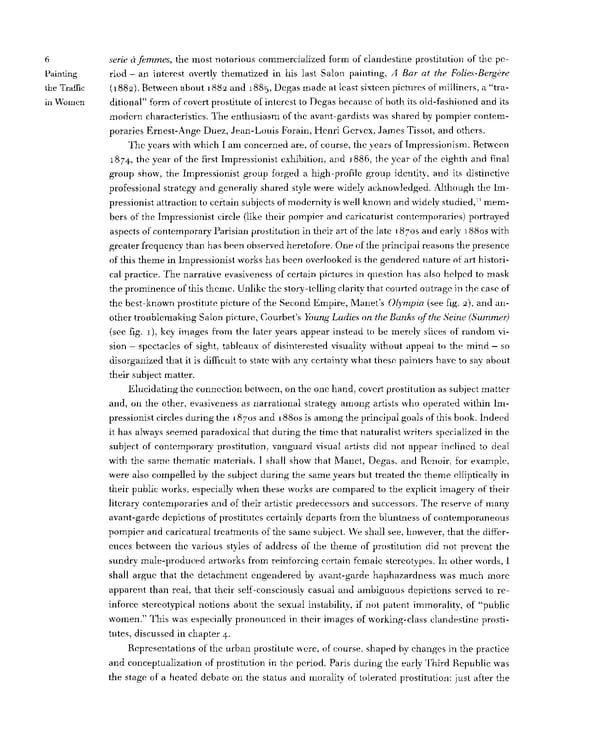serie dfemmes, the most notorious commercialized form of clandestine prostitution of the pe- 6 Painting riod — an interest overtly thematized in his last Salon painting, A Bar at the Folies-Bergere the Traffic (1882). Between about 1882 and 1885, Degas made at least sixteen pictures of milliners, a "tra- in Women ditional" form of covert prostitute of interest to Degas because of both its old-fashioned and its modern characteristics. The enthusiasm of the avant-gardists was shared by pompier contem- poraries Ernest-Ange Duez, Jean-Louis Forain, Henri Gervex, James Tissot, and others. The years with which I am concerned are, of course, the years of Impressionism. Between 1874, the year of the first Impressionist exhibition, and 1886, the year of the eighth and final group show, the Impressionist group forged a high-profile group identity, and its distinctive professional strategy and generally shared style were widely acknowledged. Although the Im- 11 pressionist attraction to certain subjects of modernity is well known and widely studied, mem- bers of the Impressionist circle (like their pompier and caricaturist contemporaries) portrayed aspects of contemporary Parisian prostitution in their art of the late 18708 and early 188os with greater frequency than has been observed heretofore. One of the principal reasons the presence of this theme in Impressionist works has been overlooked is the gendered nature of art histori- cal practice. The narrative evasiveness of certain pictures in question has also helped to mask the prominence of this theme. Unlike the story-telling clarity that courted outrage in the case of the best-known prostitute picture of the Second Empire, Manet's Olympia (see fig. 2), and an- other troublemaking Salon picture, Courbet's Young Ladies on the Banks of the Seine (Summer) (see fig. i), key images from the later years appear instead to be merely slices of random vi- sion — spectacles of sight, tableaux of disinterested visuality without appeal to the mind — so disorganized that it is difficult to state with any certainty what these painters have to say about their subject matter. Elucidating the connection between, on the one hand, covert prostitution as subject matter and, on the other, evasiveness as narrational strategy among artists who operated within Im- pressionist circles during the 18705 and i88os is among the principal goals of this book. Indeed it has always seemed paradoxical that during the time that naturalist writers specialized in the subject of contemporary prostitution, vanguard visual artists did not appear inclined to deal with the same thematic materials. I shall show that Manet, Degas, and Renoir, for example, were also compelled by the subject during the same years but treated the theme elliptically in their public works, especially when these works are compared to the explicit imagery of their literary contemporaries and of their artistic predecessors and successors. The reserve of many avant-garde depictions of prostitutes certainly departs from the bluntness of contemporaneous pompier and caricatural treatments of the same subject. We shall see, however, that the differ- ences between the various styles of address of the theme of prostitution did not prevent the sundry male-produced artworks from reinforcing certain female stereotypes. In other words, I shall argue that the detachment engendered by avant-garde haphazardness was much more apparent than real, that their self-consciously casual and ambiguous depictions served to re- inforce stereotypical notions about the sexual instability, if not patent immorality, of "public women." This was especially pronounced in their images of working-class clandestine prosti- tutes, discussed in chapter 4. Representations of the urban prostitute were, of course, shaped by changes in the practice and conceptualization of prostitution in the period. Paris during the early Third Republic was the stage of a heated debate on the status and morality of tolerated prostitution: just after the
 Prostitution & Impressionists Page 26 Page 28
Prostitution & Impressionists Page 26 Page 28